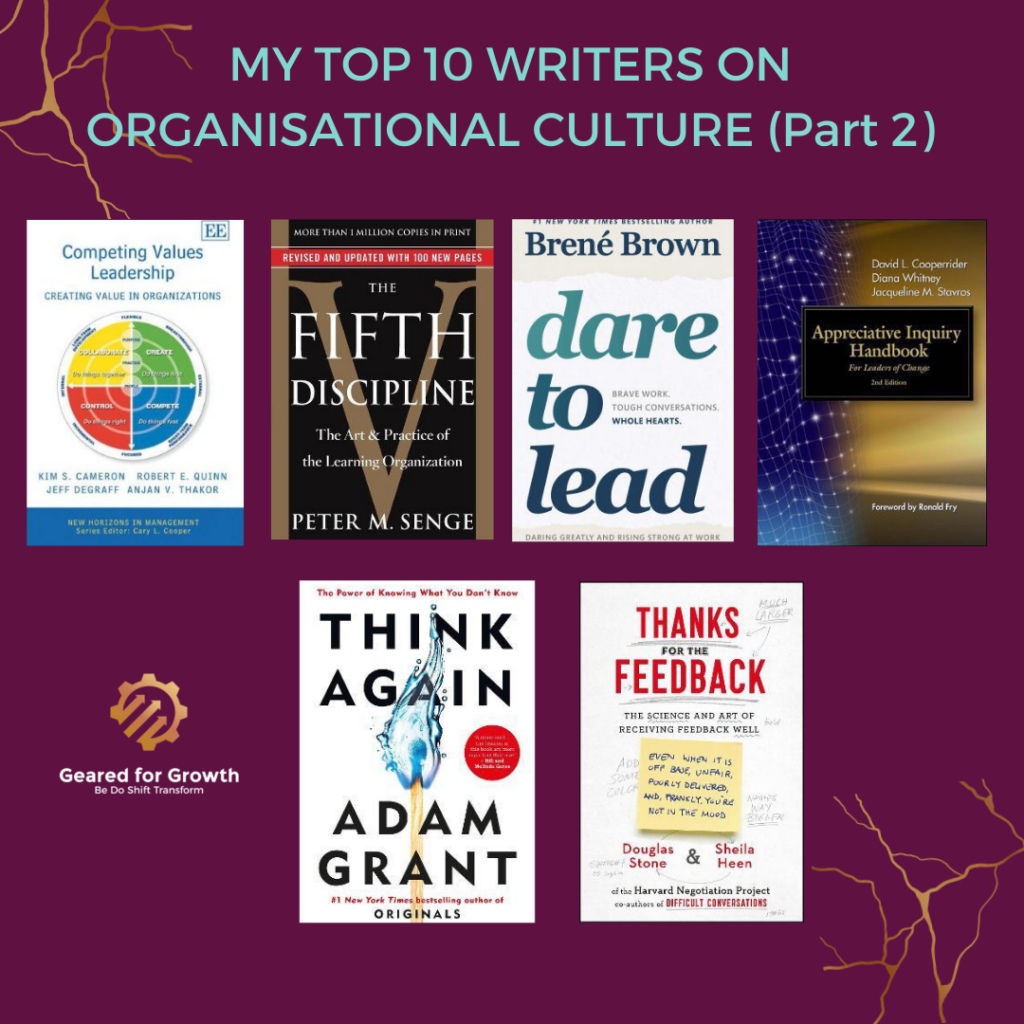# 5 Kim Cameron and Robert Quinn
Kim Sterling Cameron, William Russell Kelly Professor of Management and Organisations at the Ross School of Business at the University of Michigan and Robert E. Quinn, Margaret Elliot Tracy Professor Emeritus at the University of Michigan, Ross School of Business, are two co-founders of the Center for Positive Organisations.
They developed a culture model, The Competing Values Framework (CVF), that classifies different organisational cultures according to two dimensions. The vertical axis describes the degree of stability or flexibility. The horizontal axis describes whether the organisational perspective faces inwards or outwards.

The CVF describes 4 levels of culture:
- Adhocracy Culture which is a dynamic, creative, and entrepreneurial working environment. The leaders are innovative and risk-taking.
- Clan Culture which is people-oriented and very friendly working environment. The leaders are mentors and benevolent.
- Hierarchy Culture which is process-oriented, formalized, and structured. The leaders are efficient and organized.
- Market Culture which is results-oriented and competitive. The leaders are tough, driven and competitive.
#6 Peter Senge
Peter Michael Senge, an American systems scientist at the MIT Sloan School of Management and the founder of the Society for Organisational Learning, is a leading figure in organisational learning. His most popular book, The Fifth Discipline, provides theories and methods that help understand the complexity of learning-oriented organisational cultures.
The five disciplines include:
1. A shared Vision
2. Mental Models
3. Team Learning
4. Personal Mastery
5. System Thinking

When a vision is shared, employees and management work towards common goals. People can have different mental models which is why it is important that they reflect on their own behaviours and beliefs. In doing so, they will be able to align their values to that of the organisation. Openness is very important in achieving team learning. Working in teams allows collaboration and efficiency.
The fifth discipline, System Thinking, encourages an organisation to look into patterns of thoughts and behaviours as a whole rather than separate parts. These parts function together to produce desired results.
#7 Brene Brown
Brené Brown, an American professor, research, and author, is famous for her research on shame, vulnerability, and leadership. Her book, Dare to Lead, calls for a commitment to grow as leaders though interpersonal communication skill building. It also describes modern workplace culture and promotes four skillsets for courageous leadership.

- Rumbling with vulnerability: Have the courage to deal with conversations that make you feel vulnerable.
- Living into your values: Walk the talk, be clear about your values and think/act in alignment with those beliefs.
- Braving Trust: Talk about trust in tangible and direct rather than vague terms. Be open to being the First To Trust
- Learning to Rise: Before you dive into vulnerability, prepare yourself with the skills and system to rise from failures.
#8 David Cooperrider
David L. Cooperrider, a University Professor at Case Western Reserve University, received “The Lifetime Achievement Award” in his field of Organisation Development and the OD Network for his work on Appreciative Inquiry.
Appreciative Inquiry (AI) is a strengths-based, positive approach to leadership development and organisational change which uses a non-hierarchical participatory approach to help people engage in strategic innovation by understanding best practices, changing culture, and creating momentum. AI relies on momentum being driven from a bottom up, employee response rather than a top down management response. AI in fact is a forerunner to Design Thinking which is widely used in organisations today.

The AI process follow four distinct phases, called the 4-D Cycle:
- Discovery: exploring “the best of what is,” identifying the organisation’s strengths, best practices, sources of excellence, vitality, and peak performance.
- Dream: envisioning a future together where the organisation is fully engaged and successful around its core purpose and strategic objectives.
- Design: co-creating and designing high-impact strategies that move the organisation creatively and decisively in the right direction.
- Destiny (sometimes also called Deploy): putting the strategies into action, revising as necessary.
#9 Adam Grant
ADAM GRANT, an organisational psychologist at Wharton Univeristy, believes: “We learn more from people who challenge our thought process than those who affirm our conclusions. Strong leaders engage their critics and make themselves stronger. Weak leaders silence their critics and make themselves weaker.” Adam has a real knack for translating the science of organisational psychology to everyday business practices. He currently has a popular podcast that I enjoy called Work Life with Adam Grant.

His book, Think Again, espouses the importance of a psychological safe space where people can acknowledge that they are wrong, that they can change their mind, and that they can challenge each other in a healthy way. This kind of humble and flexible thinking makes for an inspirational and effective leader, who can admit when they are wrong. The book is divided into three parts:
Part 1: “Individual Rethinking: Updating Our Own Views”
Part 2: “Interpersonal Rethinking: Opening Other People’s Minds”
Part 3: “Collective Rethinking: Creating Communities of Lifelong Learners”
# 10 Douglas Stone and Sheila Heen
Douglas Stone and Sheila Heen are cofounders of Triad Consulting Group and lecturers in Law at Harvard Law School, specifically on corporate education, mediation, and consulting to every kind of organisation.
They wrote two seminal books on relationships in organisations: Difficult Conversations: How to discuss what matters most, and Thanks for the Feedback: The Science and Art of receiving feedback well. People often choose to avoid difficult conversations but they carry with them insights and realisations to the most complex situations that need to be resolved. Similarly, people dread and even dismiss feedback and yet it is essential for professional development and healthy relationships.
Whilst these authors don’t write about organisational culture per se, they have a wealth of practical strategies for having more authentic and open conversations and more effective relationships within organisations, which is a critical factor in developing a strong and more open culture to drive innovation, growth and productivity.


